Hull J.C. Risk management and Financial institutions
Подождите немного. Документ загружается.


Valuing European Options 415
the option is 53.44, the delta of the option is 0.45, the gamma is 0.0023, the
theta is -0.22, the vega is 3.33, and rho is 2.44. Note that the formula in
Table C.l gives theta per year. The theta quoted here is per calendar day.
The calculations in this appendix can be done with the DerivaGem
software on the author's website by selecting Analytic European for the
Option Type. Option valuation is described more fully in Hull (2006).
1
1
See J. C. Hull, Options, Futures, and Other Derivatives, 6th edn., Prentice Hall, 2006.
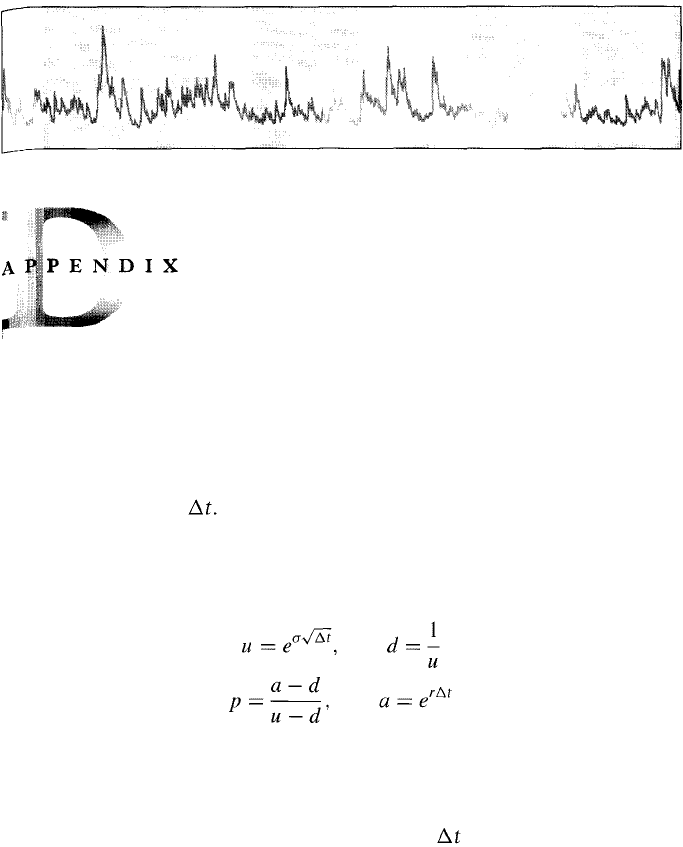
Valuing
American Options
To value American-style options, we divide the life of the option into n
time steps of length Suppose that the asset price at the beginning of a
step is S. At the end of the time step it moves up to Su with probability p
and down to Sd with probability 1 — p. For an investment asset that
provides no income, the values of u, d and p are given by
Figure D.l shows the tree constructed for valuing a five-month American
put option on a non-dividend-paying stock where the initial stock price is
50, the strike price is 50, the risk-free rate is 10%, and the volatility is
40%. In this case, there are five steps, so that = 0.08333, u = 1.1224,
d = 0.8909, a — 1.0084, and p = 0.5073. The upper number at each node
is the stock price and the lower number is the value of the option.
At the final nodes of the tree the option price is its intrinsic value. For
example, at node G the option price is 50 — 35.36 = 14.64. At earlier nodes
we first calculate a value assuming that the option is held for a further time
period of length At and then check to see whether early exercise is optimal.
Consider first node E. If the option is held for a further time period it will
be worth 0.00 if there is an up move (probability: p) and 5.45 if there is a
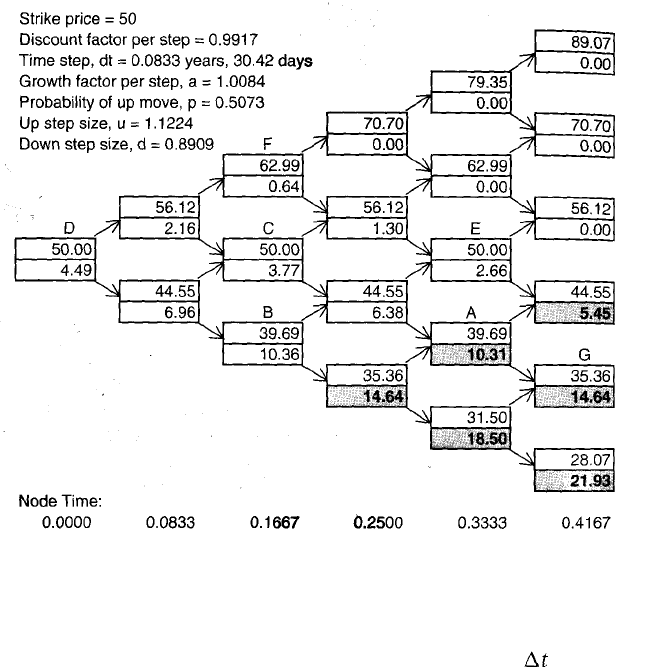
418
Appendix D
Figure D.1 Binomial tree from DerivaGem for an American put on a
non-dividend-paying stock.
down move (probability: 1 — p). The expected value in time is therefore
0.5073 x 0 + 0.4927 x 5.45, or 2.686, and the 2.66 value at node E is
calculated by discounting this at the risk-free rate of 10% for one month.
The option should not be exercised at node E as the payoff from early
exercise would be zero. Consider next node A. A similar calculation to that
just given shows that, assuming it is held for a further time period, the
option's value at node A is 9.90. If exercised, its value is 50 — 39.69 =
10.31. In this case, it should be exercised and the value of being at node A
is 10.31.
Continuing to work back from the end of the tree to the beginning, the
value of the option at the initial node D is found to be 4.49. As the number
of steps on the tree is increased, the accuracy of the option price increases.
At each node:
Upper value = Underlying Asset Price
Lower value = Option Price
Shading indicates where option is exercised
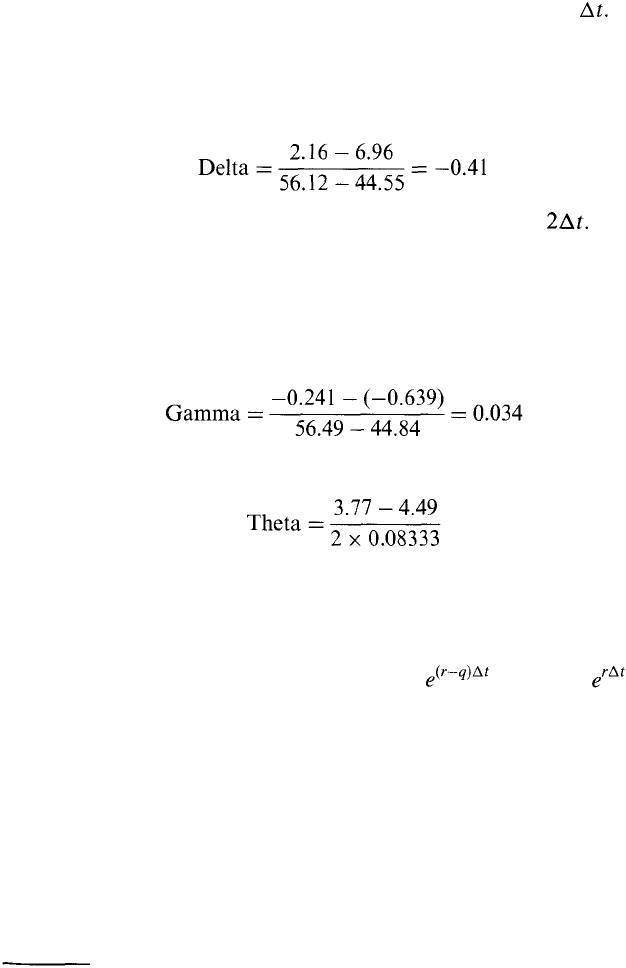
Valuing American Options 419
With 30, 50, and 100 time steps, we get values for the option of 4.263,
4.272, and 4.278.
To calculate delta, we consider the two nodes at time In our
example, as we move from the lower node to the upper node the option
price changes from 6.96 to 2.16 and the stock price changes from 44.55 to
56.12. The estimate of delta is the change in the option price divided by
the change in the stock price:
To calculate gamma, we consider the three nodes at time The delta
calculated from the upper two nodes (C and F) is —0.241. This can be
regarded as the delta for a stock price of (62.99 + 50)/2 = 56.49. The
delta calculated from the lower two nodes (B and C) is —0.639. This can
be regarded as the delta for a stock price of (50 + 39.69)/2 = 44.84. The
estimate of gamma is the change in delta divided by the change in the
stock price:
We estimate theta from nodes D and C as
or —4.30 per year. This is -0.0118 per calendar day. Vega is estimated by
increasing the volatility, constructing a new tree, and observing the effect
of the increased volatility on the option price. Rho is calculated similarly.
When the asset underlying the option provides a yield at rate q the
procedure is exactly the same except that a = instead of in the
equation for p. The calculations we have described can be done using the
DerivaGem software by selecting Binomial American for the Option
Type. Binomial trees and other numerical procedures are described more
fully in Hull (2006).
1
1
See J. C. Hull, Options, Futures, and Other Derivatives, 6th edn., Prentice Hall, 2006.
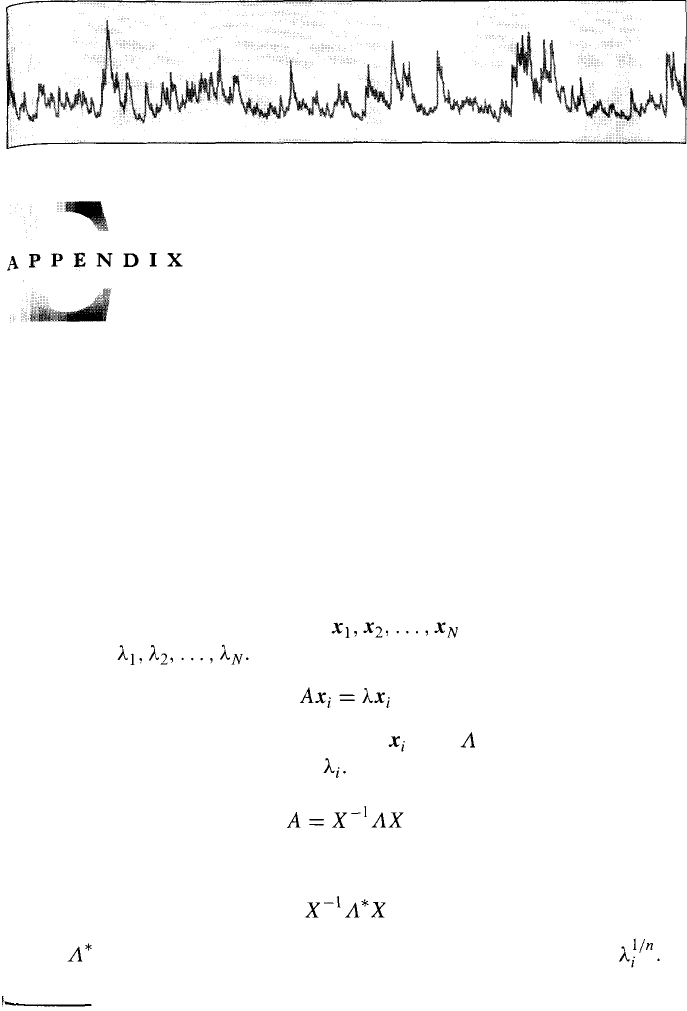
Suppose that A is an N x N matrix of credit rating changes in one year.
This is a matrix such as the one shown in Table 12.1. The matrix of credit
rating changes in m years is A
m
. This can be readily calculated using the
normal rules for matrix multiplication.
The matrix corresponding to a shorter period than one year, say six
months or one month, is more difficult to compute. We first use standard
routines to calculate eigenvectors and the corresponding
eigenvalues These have the property that
Define X as a matrix whose ith row is and a s a diagonal matrix
where the ith diagonal element is A standard result in matrix algebra
shows that
From this it is easy to see that the nth root of A is
where is a diagonal matrix where the ith diagonal element is
Some authors, such as Jarrow, Lando, and Turnbull,
1
prefer to handle
1
See R. A. Jarrow, D. Lando, and S. M. Turnbull, "A Markov Model for the Term
Structure of Credit Spreads," Review of Financial Studies, 10 (1997), 481-523.
The Manipulation
of Credit Transition
Matrices

422
Appendix E
this problem in terms of what is termed a generator matrix. This is a
matrix such that the transition matrix for a short period of time is
I + where I is the identity matrix, and the transition matrix for a
longer period of time t is
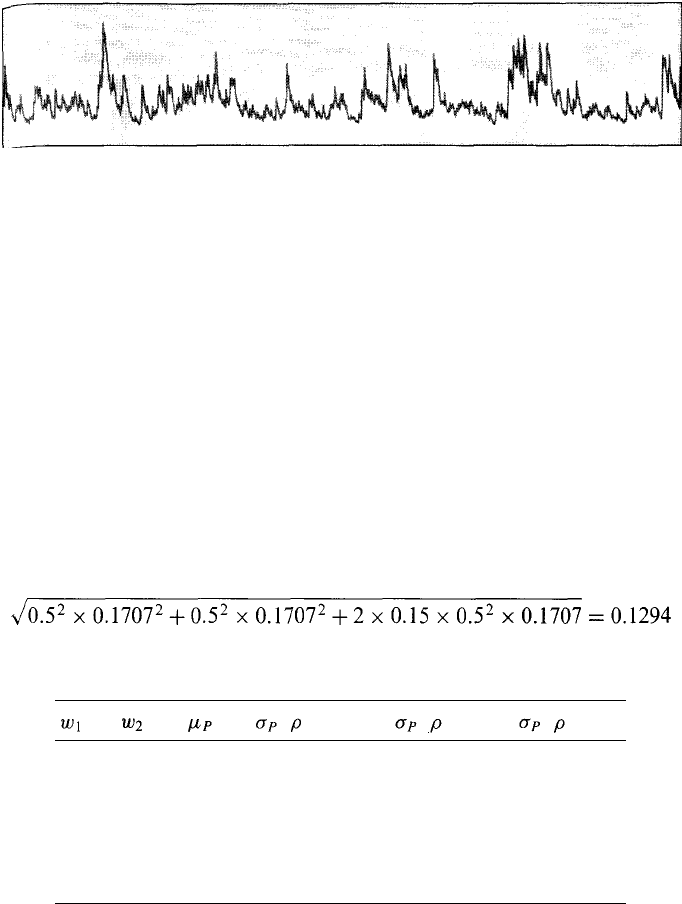
Answers to Questions
and Problems
CHAPTER 1
1.1. Expected return is 12.5%. SD of return is 17.07%.
1.2. From equations (1.1) and 1.2), expected return is 12.5%. SD of
return is
or 12.94%.
1.3.
0.0
0.2
0.4
0.6
0.8
1.0
1.0
0.8
0.6
0.4
0.2
0.0
15%
14%
13%
12%
11%
10%
( =0.3)
24.00%
20.39%
17.42%
15.48%
14.96%
16.00%
( =1)
24.00%
22.40%
20.80%
19.20%
17.60%
16.00%
( =-1)
24.00%
16.00%
8.00%
0.00%
8.00%
16.00%
1.4. Nonsystematic risk can be diversified; systematic risk cannot. Sys-
tematic risk is most important to an equity investor. Either type of risk
can lead to the bankruptcy of a corporation.
1.5. We assume that investors trade off mean return and standard
deviation of return. For a given mean return, they want to minimize
424 Answers to Problems and Questions
standard deviation of returns. All make the same estimates of means
standard deviations, and coefficients of correlation for returns on indi-
vidual investments. Furthermore they can borrow or lend at the risk-free
rate. The result is that they all want to be on the "new efficient frontier"
in Figure 1.4. They choose the same portfolio of risky investments
combined with borrowing or lending at the risk-free rate.
1.6. (a) 7.2%, (b) 9%, (c) 14.4%.
1.7. The capital asset pricing theory assumes that there is one factor
driving returns. Arbitrage pricing theory assumes multiple factors.
1.8. In many jurisdictions, interest on debt is deductible to the corporation
whereas dividends are not deductible. It can therefore be more tax efficient
for a company to fund itself with debt. However, as debt increases, the
probability of bankruptcy increases.
1.9. When potential losses are large, we cannot aggregate them and
assume they will be diversified away. It is necessary to consider them
one by one and handle them with insurance contracts, tighter internal
controls, etc.
1.10. This is the probability that profit is no worse than —4% of assets.
This profit level is 4.6/1.5 = 3.067 standard deviations from the mean. The
probability that the bank will have a positive equity is therefore N(3.067),
where N is the cumulative normal distribution function. This is 99.89%.
1.11. Banks have the privilege of being allowed to take money from
depositors. Companies in retailing and manufacturing do not.
1.12. There was an interest rate mismatch at Continental Illinois. About
$5.5 billion of loans with maturities more than a year were financed by
deposits with maturities less than a year. If interest rates rose 1%, the
deposits would be rolled over at higher rates while the loans would
continue to earn the same rate. The cost to Continental Illinois would
be $55 million.
1.13. S&Ls financed long-term fixed-rate mortgages with short-term
deposits creating a serious interest rate mismatch. As a result, they lost
money when interest rates rose.
1.14. In this case, the interest rate mismatch is $10 billion. The bank's net
interest income declines $100 million each year for the next three years.
1.15. Professional fees ($5 million per month), lost sales (people are
reluctant to do business with a company that is being reorganized), and
key senior executives left (lack of continuity).
Answers to Problems and Questions 425
CHAPTER 2
2.1. When a trader enters into a long forward contract, she is agreeing to
buy the underlying asset for a certain price at a certain time in the future.
When a trader enters into a short forward contract, she is agreeing to sell
the underlying asset for a certain price at a certain time in the future.
2.2. A trader is hedging when she has an exposure to the price of an asset
and takes a position in a derivative to offset the exposure. In a speculation
the trader has no exposure to offset. She is betting on the future move-
ments in the price of the asset. Arbitrage involves taking a position in two
or more different markets to lock in a profit.
2.3. In the first case, the trader is obligated to buy the asset for $50 (she
does not have a choice). In the second case, the trader has an option to
buy the asset for $50 (she does not have to exercise the option).
2.4. Selling a call option involves giving someone else the right to buy an
asset from you for a certain price. Buying a put option gives you the right
to sell the asset to someone else.
2.5. (a) The investor is obligated to sell pounds for 1.5000 when they are
worth 1.4900. The gain is (1.5000 - 1.4900) x 100,000 = $1,000. (b) The
investor is obligated to sell pounds for 1.5000 when they are worth 1.5200.
The loss is (1.5200 - 1.5000) x 100,000 = $2,000.
2.6. (a) The trader sells for 50 cents per pound something that is worth
48.20 cents per pound. Gain = ($0.5000 - $0.4820) x 50,000 = $900.
(b) The trader sells for 50 cents per pound something that is worth 51.30
cents per pound. Loss = ($0.5130 - $0.5000) x 50,000 = $650.
2.7. You have sold a put option. You have agreed to buy 100 shares for
$40 per share if the party on the other side of the contract chooses to
exercise the right to sell for this price. The option will be exercised only
when the price of stock is below $40. Suppose, for example, that the
option is exercised when the price is $30. You have to buy at $40 shares
that are worth $30; you lose $10 per share, or $1,000 in total. If the
option is exercised when the price is $20, you lose $20 per share, or $2,000
in total. The worst that can happen is that the price of the stock declines
to almost zero during the three-month period. This highly unlikely event
would cost you $4,000. In return for the possible future losses, you receive
the price of the option from the purchaser.
2.8. The over-the-counter (OTC) market is a telephone- and computer-
linked network of financial institutions, fund managers, and corporate
treasurers where two participants can enter into any mutually acceptable
426
Answers to Problems and Questions
contract. An exchange-traded market is a market organized by an ex-
change where traders either meet physically or communicate electronically
and the contracts that can be traded have been defined by the exchange
(a) OTC, (b) exchange, (c) both, (d) OTC, (e) OTC.
2.9. One strategy would be to buy 200 shares. Another would be to buy
2,000 options. If the share price does well, the second strategy will give
rise to greater gains. For example, if the share price goes up to $40, you
gain [2, 000 x ($40 - $30)] - $5,800 = $14,200 from the second strategy
and only 200 x ($40 - $29) = $2,200 from the first. However, if the
share price does badly, the second strategy gives greater losses. For
example, if the share price goes down to $25, the first strategy leads
to a loss of 200 x ($29 — $25) = $800, whereas the second strategy leads
to a loss of the whole $5,800 investment. This example shows that
options contain built in leverage.
2.10. You could buy 5,000 put options (or 50 contracts) with a strike
price of $25 and an expiration date in 4 months. This provides a type of
insurance. If at the end of 4 months the stock price proves to be less than
$25, you can exercise the options and sell the shares for $25 each. The
cost of this strategy is the price you pay for the put options.
2.11. A stock option provides no funds for the company. It is a security
sold by one trader to another. The company is not involved. By contrast,
a stock when it is first issued is a claim sold by the company to investors
and does provide funds for the company.
2.12. Ignoring the time value of money, the holder of the option will
make a profit if the stock price in March is greater than $52.50. This is
because the payoff to the holder of the option is, in these circumstances,
greater than the $2.50 paid for the option. The option will be exercised if
the stock price at maturity is greater than $50.00. Note that if the stock
price is between $50.00 and $52.50 the option is exercised, but the holder
of the option takes a loss overall.
2.13. Ignoring the time value of money, the seller of the option will make
a profit if the stock price in June is greater than $56.00. This is because
the cost to the seller of the option is in these circumstances less than the
price received for the option. The option will be exercised if the stock
price at maturity is less than $60.00. Note that if the stock price is
between $56.00 and $60.00 then the seller of the option makes a profit
even though the option is exercised.
